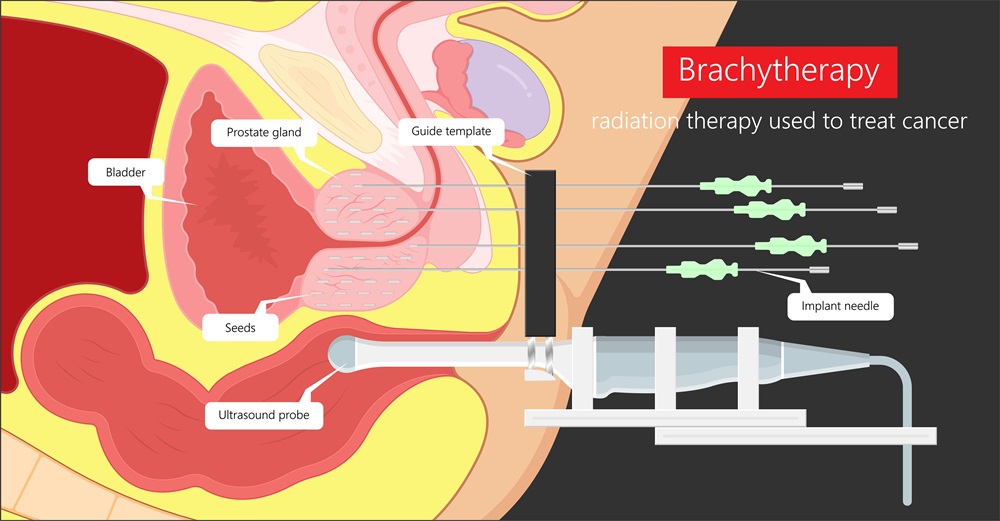What is Brachytherapy and what does it involve
Brachytherapy is a form of radiotherapy where the radiation sources itself (radioactive seeds) are placed in the area being treated. There are two types of brachytherapy: low dose rate where permanent radioactive seeds are implanted and high dose rate where radioactive materials within hollow needles are temporarily placed in the prostate, this is used in conjunction with external beam radiotherapy.
Low dose rate brachytherapy (or interstitial brachytherapy) is when radioactive seeds are implanted into the prostate gland with the assistance of an ultrasound machine for guidance of correct positioning. The number of seeds is determined by the doctor as each patient requires tailored treatment. A urologist and a radiation oncologist perform the procedure together.

How long does the procedure take?
The procedure usually takes 90minutes with many patients going home the same day.
Catheter on discharge
There will be some blood in the catheter once discharged home, this is normal and should settle in the next few days before removal of catheter. Your catheter should be connected to a leg bag and the care of the bag will be explained to you by a nurse before discharge.
Going back to work?
Patients can usually resume normal work within 2-3 days.
Are the seeds ever removed?
No, the seeds remain in your prostate for your lifetime and will gradually lose their radioactivity over time, normally within a year of implantation.
The seeds may come out when you go to the toilet. It is unlikely. If a seed does come out, do not touch it. Pick it up using tweezers or tongs and flush it down the toilet. Contact your consultant to let them know.
Do you need to use protection during intercourse after seed implantation
It is safe to have sex and sleep in the same bed as your partner after treatment. For a few months, when having sex you should wear a condom. In some cases radioactive seeds can dislodge and be passed out during ejaculation.
Children and pets sitting on laps of people who have undergone seed implantation
It is recommended that you don’t spend a long time with children or pregnant women for 2 months after treatment. After 2 months the radiation is almost gone. After 4 to 6 months, the radiation level falls very low. It is barely there at all and cannot even be measured on a scan.
Pets are allowed for short periods of a couple of minutes and there are no current studies that have been undertaken with pets.
Flomaxtra or Duodart post seed implantation
The doctor will usually prescribe Flomaxtra post surgery but if you are already on Duodart, continue to take your regular dose.
When can you return to sports or lifting
Sports and lifting can resume when the patient feels comfortable to do so. It is not like an open procedure, so the recovery time is a lot faster.
Possible side effects following Brachytherapy
Immediately after the procedure patients may have some perineal discomfort and even some bruising for a few days. Patients often experience urinary frequency, urgency, weak stream and nocturia. These effects are most at 4-6 weeks after Brachytherapy and will settle over the following 3-6months. Erectile problems may also occur but is less common with low dose rate Brachytherapy compared to high dose rate brachytherapy. 3-6 months.
MRI scan pre removal of catheter
Before having your catheter removed you will be asked to have a MRI scan done on the morning of appointment with the Drs Nurse. For this scan you a required to fast. They should be in contact with your directly, if not please call the doctors rooms to clarify information.
Follow up appointment will be within 4-6 weeks
Any questions regarding number of seeds, pathology and MRI scan will be discussed at this appointment as the doctor will need to review your files before seeing you again.
If you have any questions or queries please call the doctors rooms on 7231 0433
If you have any questions or queries please call the doctors rooms on 7231 0433
REFERENCES:
Prostate Cancer Treatment side effects; Prostate Cancer treatment Results Foundation, Seattle; 2014 Content contributed by R. Alex Hsi, M.D., Peninsula Cancer Center
Prostate Cancer Treatments; Prostate Cancer treatment Results Foundation, Seattle; 2014 Content contributed by R. Alex Hsi, M.D., Peninsula Cancer Center
Brachytherapy (Radioactive Seed Implantation Therapy) in Prostate Cancer; Lanna Cheuck, DO; Chief Editor: Edward David Kim, MD, FACS; updated 16/12/2015
Barachytherapy for Prostate Cancer; This fact sheet has been produced by the Genitourinary Oncology Special Advisory Group (SAG) of the Urological Society of Australia and New Zealand
Internal radiotherapy (brachytherapy) for prostate cancer; Cancer Research UK; updated 25/2/2014
Fast Facts: Prostate Cancer; Roger S Kirby and Manish I Patel; seventh edition January 2012
Prostate Cancer Your guide to the disease, treatment options and outcomes; Associate Professor Prem Rashid MBBS, FRACGP FRACS PhD 2010, foreword by Professor Villis Marshall MBBS MD FRACS AC
Promoting Wellness for Prostate Cancer Patients; Mark A. Moyad, MD, MPH; third edition2010
Understanding Prostate Cancer A guide for men with cancer, their families and friends; The Cancer Council New South Wales; revised 2009
Localised prostate cancer; Australian Prostate Cancer Colaboration Inc, Australian Cancer Network; 3rd edition July 2006
